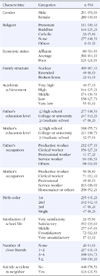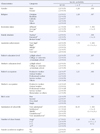Abstract
Purpose
This study was done to identify predictive factors influencing suicide probability in Korean adolescents.
Methods
Participants in the study were 575 adolescents from 17 schools with quota sampling by each region in D city. The data were collected from October to November, 2010 using self-report questionnaires about interpersonal relationships and suicide probability (SPS) and analyzed using descriptive statistics, one-way ANOVA with Scheffe of Post Hoc, Pearson's correlation coefficients, and stepwise multiple regression analysis with SPSS/WIN 16.0 program.
Results
Suicide probability showed a significantly negative correlation for interpersonal relations with parents, friends and teachers. Interpersonal relationship with parents (p<.001) explained 32% of suicide probability, compared to relationships with peers or teachers, which together was accounted for 46% of the variance.
References
1. Ayyash-Abdo H. Adolescent suicide: An ecological approach. Psychol Sch. 2002. 39:459–475.
2. Baldry AD, Winkel FW. Direct and vicarious and victimization at school and at home as risk factors suicidal cognition among Italian adolescents. J Adolesc. 2003. 26:703–716.
3. Beautrais AL, Joyce PR, Mulder RT. Risk factors for serious suicide attempts among youths aged 13 through 24 years. J Am Acad Child Adolesc Psychiatry. 1996. 35:1174–1182.
4. Beck AT, Brown G, Berchick RJ, Stewart BL, Steer RA. Relationship between hopelessness and ultimate suicide: A replication with psychiatric outpatients. Am J Psychiatry. 1990. 147:190–195.
5. Bostik KE, Everall RD. Healing from suicide: Adolescent perceptions of attachment relationships. Br J Guid Counc. 2007. 35:79–96.

6. Chung HK, Ahn OH, Kim KH. Predicting factors on youth suicide impulse. Korean J Youth Stud. 2003. 10:107–126.

7. Cull GJ, Gill SW. Suicide probability scale (SPS) manual. 1988. Los Angeles: Western Psycho Logical Services.
8. Esposito CL, Clum GA. Social support and problem-solving as moderators of the relationship between childhood abuse and suicidality: Applications to a delinquentpopulation. J Trauma Stress. 2002. 15:137–146.
9. Fergusson DM, Woodward LJ, Horwood LJ. Risk factors and life processes associated with the onset of suicidal behavior during adolescence and early adulthood. Psychol Med. 2000. 30:23–39.

10. Go HJ, Kim DJ, Lee HP. A validation study of suicidal probability scale for adolescents(SPS-A). J Korean Neuropsychiatr Assoc. 2000. 39:680–690.

11. Goldston DB, Daniel S, Rebousin B, Reboussin D, Frazier P, Harrris A. Cognitive risk factors and suicide attempts among formerly hospitalized adolescents: A prospective naturalistic study. J Am Acad Child Adolesc Psychiatry. 2001. 40:91–99.
12. Gotlib IH, Hammen CL. Psychological aspects of depression: Towards a cognitive-interpersonal integration. 1992. Chichester: Wiley.
13. Kaplan PS. Adolescence. 2004. Houghton: Mifflin Company.
14. Kim BY, Lee CS. A meta-analysis of variables related to suicidal ideation in adolescents. J Korean Acad Nurs. 2009. 39:651–661.
15. Kim HS. Correlation between personality, family dynamic environment and suicidal attempt among Korean adolescent population. J Korean Acad Nurs. 2002. 32:231–242.
16. Kim KW, Chun MH. Study on the teenage suicide. J Korean Soc Child Welf. 2000. 9:128–152.
17. Kim YH, Park YS, Kim UC. Environmental, psychological, and behavioral factors that influence adolescentdelinquency. J Child Educ. 2004. 13:201–219.
18. King C, Merchant C. Social and interpersonal factors relating to adolescent suicidality: A review of the literature. Arch Suicide Res. 2008. 12:181–196.
19. Moon ES. A structural analysis of the social and psychological variables related to adolescents' school adjustment behaviors. Unpublished master's thesis. 2002. Daejeon: Chungnam National University.

20. Murray C, Greenberg MT. Children's relationship with teachers and bonds with school: An investigation of patterns and correlates in middle childhood. J Sch Psychol. 2000. 38:423–445.

21. Nolten PW. Conceptualization and measurement of social support: The development of the student social support scale. Unpublished doctoral dissertation. 1994. Madison, USA: University of Wisconsin-Madison.
22. OECD Health Data. Suicides, death per 100,000 population. 2011. Retrieved March 20, 2012. from: http://stat.oecd.org/Index.aspx?DataSetCode=HEALTH_STAT.
23. Oh HA, Park YR, Choi MH. The effects of parent-adolescent communication and depression on suicide ideation. J Korean Acad Child Health Nurs. 2008. 14:35–43.

24. Park AC, Woo CY. The relationship among high school students' attachment for their parents and peers depending on gender, self-identity, and career decision-making levels. Korean J Educ Psychol. 2008. 22:69–85.

25. Park HS, Jung SY. Development of multisystem core competency support model to prevent suicidal ideation in adolescents. J Korean Acad Psychiatr Ment Health Nurs. 2010. 19:278–287.

26. Park YS, Kim UC. The quality of life and interpersonal relationships among Korean adolescents. Korean J Educ Psychol. 2008. 22:801–836.

27. Paulson BL, Everall RD. Suicidal adolescents: Helpful aspects of psychotherapy. Arch Suicide Res. 2003. 7:309–321.
28. Schotte DE, Clum GA. Problem-solving skills in suicidal psychiatric patients. J Consult Clin Psychol. 1987. 55:49–54.
29. Statistics Korea. Statistics of suicide rate in population. 2011. Retrieved August 20, 2011. Available from: http://kosis.kr/themes/themes_04List.jsp.
30. Tabachnick BG, Fidell IS. Using multi-variate statistics. 1989. New York: Collins.




 PDF
PDF ePub
ePub Citation
Citation Print
Print







 XML Download
XML Download